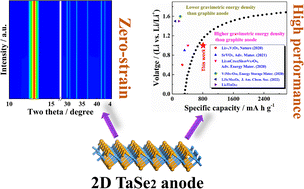2D TaSe2 as a zero-strain and high-performance anode material for Li+ storage†
Abstract
The zero-strain property of anode materials plays a determining role in their safety and cycling performance. However, the zero-strain anode materials currently developed are very limited and show significant performance trade-offs. Herein, novel highly conductive two-dimensional (2D) TaSe2 is first explored as an anode material. Due to the reaction mechanism of Li+ solid-solution, the 2D TaSe2 anode shows the zero-strain feature (0.042%) at full lithiation, resulting in excellent cycling stability. Owing to the dual active sites (Ta and Se atoms) and the double-sided Li+ storage mechanism, the 2D TaSe2 anode exhibits the highest specific capacity of zero-strain anode materials, and it is the only zero-strain anode material that exceeds the graphite anode in energy density. Additionally, because of its remarkable Li+/electronic conductivity and high mass density, the anode is insensitive to the loading mass (3.78–12.66 mg cm−2), resulting in high areal (9.94 mA h cm−2), volumetric (∼5 times greater than the graphite anode), and gravimetric specific capacities (the only zero-strain anode higher than the graphite anode). When matched with the high-loading LiFePO4 cathode (11.4 mg cm−2), the full cell also presents overall good performance. Experiment results combined with density functional theory (DFT) calculations are adopted together to reveal the mechanisms of Li+ storage and transfer. This work provides a good paradigm to design zero-strain and high-performance alkali-metal-ion anode materials.



 Please wait while we load your content...
Please wait while we load your content...